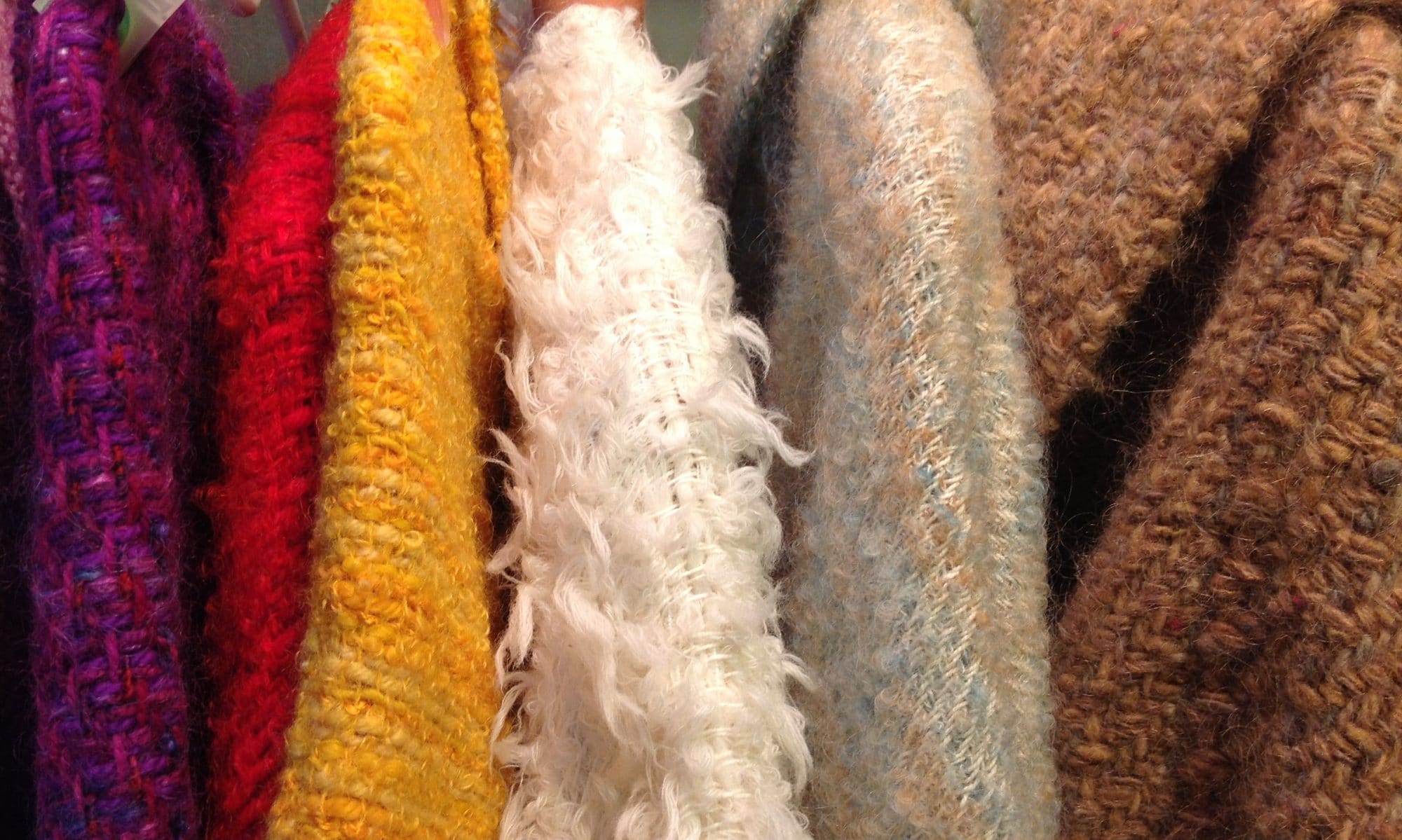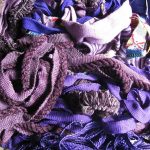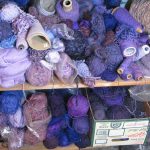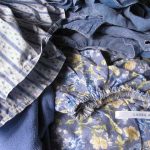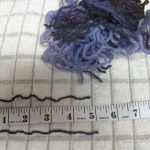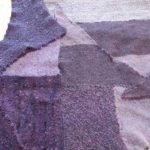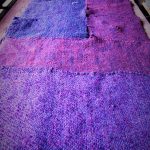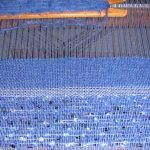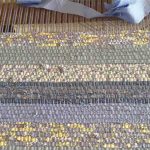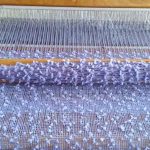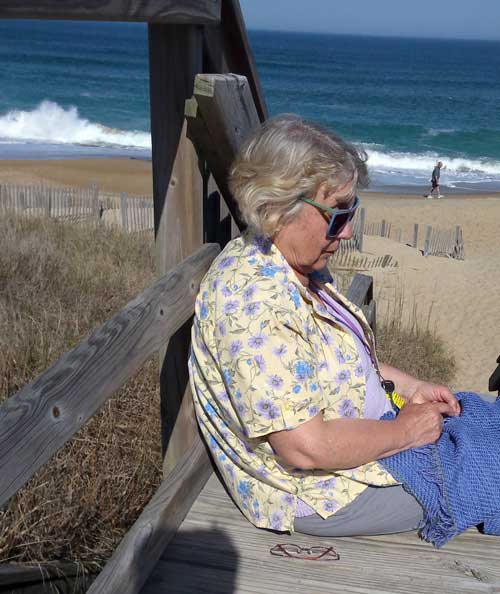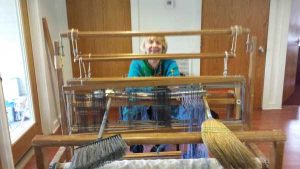
The time that we spend in Alabama in the winter is time free of a lot of the interruptions, commitments and obligations that are part of my Ontario life, so I like to have some thought-provoking projects to work on during this time frame.
This year I decided to work on some sewing and some weaving projects. I had 40 years of 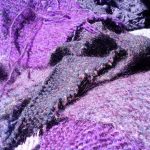 handwoven fabric scraps in purple tones. Last year I worked with the black ones and sewed them into practical and attractive clothes. Many people would have just discarded this cloth, but I know how hard I work weaving and how expensive are the yarns that I like to use, so even the leftover handwoven cloth has value to me.
handwoven fabric scraps in purple tones. Last year I worked with the black ones and sewed them into practical and attractive clothes. Many people would have just discarded this cloth, but I know how hard I work weaving and how expensive are the yarns that I like to use, so even the leftover handwoven cloth has value to me.
For my weaving project, I wound a 35 meter warp of periwinkle blue cotton before I left home and packed various yarns that I have been saving to use with a warp like this one. I also packed some beloved but tattered clothing in this colour to use to finish off the warp as rag rugs.
Starting with the sewing project, because I had lent my loom to a student for the summer and she was unable to return it to me right away, I collected the larger pieces, moved through the sizes, separating them first into pieces with some kind of hue or tone relationship, and then began to fit the pieces together.
Right off the bat I realized I had not brought enough different coloured wool threads for the hand sewing. Oh the challenges of moving a weaving studio! I had to leave some sewing to do back at home, and this is after un-weaving some unwanted cloth, as much as I could, to get some threads to sew with.
I was doing a lot of handsewing because my sewing machine would not work. Oh no. Oh yes. Usually I like to zigzag all raw ends, because I do not want anything to unravel. I am sort of neurotic about this, even though I have scraps of handwoven cloth 40 years old, and most haven’t even started to unravel. I do lightly felt my pieces because I do not like the kind of weaving that someone can poke a finger through, I like fulled cloth. So, after the crushing disappointment of the sewing machine not working, I thought upon this problem for a few days. My decision was that I would sew pieces together on both the right and the wrong sides of the piece, over the joins, and how could anything fray after that treatment? And I prefer hand work to using a machine anyway.
So, OK, time to put these pieces together. I was fortunate in that some strong unknown person had hoisted an 8 or 10 ft. picnic table onto the back veranda of the cabin that I rent. It was so perfect for laying out the pieces and fixing them together. I do love to work in the Plein Aire. The colours are so clear, decisions seem easier.
I pinned the pieces together, made sure things were laying flat, did as little cutting as I could and started sewing. It Takes Forever. These are not just pick up items. But, its so much fun for me. I learned a lot. Again. I always use the salvages as much as possible, but I started making a “virtue out of necessity”. Accentuating some awkward joins, using them as design elements. Its tricky. I started making a bump of stitching in a large piece to balance off the bulkier seam areas The pieces with fringe I want to put on the edges. (I don’t want to waste anything after all. Other adjoining pieces I unravel in order to make fringes.) These are all practical construction details and then there are the design decisions!
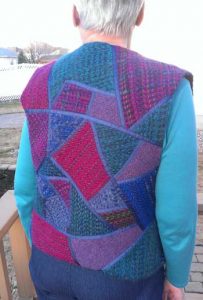
A long time ago, I took a workshop from that expert weaver and seamstress, Mary Morrisson. She had us add pieces to a fusing cloth, and iron them on. Then the join areas were covered by ribbons, thus having a thinner piece, no overlapping. For my recent projects I overlapped and did get a thicker, bulkier cloth, but that is sort of the fashion now, I even read a piece about this look in Vanity Fair! The main thing I learned is to cut pieces until they are the right shape and look good. Previously, I ruthlessly tried to join pieces without modifying their shapes. That was crazy of course.
The smaller pieces of cloth I make into lavender sachets. I used to only use rectangles, until all the rectangles were used. Then I figured how to turn a triangle into a rectangular pouch. At first I tried to minimize the seam that entailed, diagonally across the front. Then, I went wild accentuating the join, even adding buttons and other embellishments,even fringing the fold over part. It feels very creative and fun and I hope the lighthearted mood of the pieces is apparent to my clients.
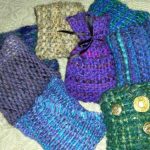
So, this whole process is the reason that when I saw Ann McElroy’s post on Facebook about using scraps to embellish felting, I felt exasperated. I could spend my whole life using up my scraps of yarn and cloth. I have tried to use them in felting, but much as I would like to use them this way, the finished pieces are not to my satisfaction. That is why I now bag them up and pass them on to Linda Tait to run through the drum carder or whatever else she does to create her textile magic. Marie Pierre Kroetsch also uses bits of yarn and many other things in her multimedia pieces. I am so impressed by her creativity too.
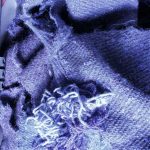 Waste not, want not is an appropriate maxim, and people seem to approach this situation with their own creative vision and skills. And that’s a good thing.
Waste not, want not is an appropriate maxim, and people seem to approach this situation with their own creative vision and skills. And that’s a good thing.
And as for my 35 meter warp? It all came together. I used pretty much all my yarn. I am coming home with teeny balls of left over yarn. I did feel rather proud of my math skills, figuring how much yarn to bring. I did have to buy some more cloth in Alabama to complete the rugs.
The Outer Banks in North Carolina was a good place to fringe, finish and sew on labels…
It has been a very creative and satisfying series of projects. Some anxious moments, some new techniques, some new ideas, lots of finished work.
